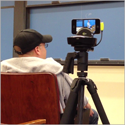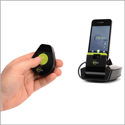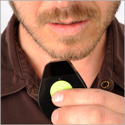Mini Case Study – the Swivl iPod/iPhone mount in action



LearnTech have been trialing the Swivl for a while, but I had my first opportunity to try it out in anger at the CAMHS Children and Young People’s Mental Heath Conference at the Sunley Management Centre on 3rd July 2013.
The organiser’s were particularly interesting in capturing video (and particulalrly audio) of two keynote addresses but had limited facilities and budget. Panopto – which is installed on the Sunley lectern – was considered but the limited range and mobility of the web cam was deemed too limiting for a guest speaker and there was a risk that the presenter would move out of microphone range. It was subsequently discovered that the first presenter had a piece of video that was important that video viewers could not view in detail. This could have been subsequently edited from the Panopto capture, but would have added complexity.
The Swivl system is designed to track and record video from an iPhone or iPod. The base unit tracks the position of the presenter using the ‘necklace’, which also contains a microphone. It is a virtually ‘one button’ system which does not distract the presenter. The device can tilt too, but this feature wasn’t required on this occasion.
A fully charged iPod could be expected to video for around 90 minutes, which is adequate for most purposes. The front or back facing cameras can be used. The latter is higher quality, but circumstances often dictate that the front is used for visibility – as a presenter you can confirm where you are in frame from time to time. High quality means a larger file too – the low-quality front camera on an iPod Touch will generate 2GB of video in 90 minutes which is not trivial for rapid processing.
In this instance we were using Swivl as a robotic camera operator – speakers had no prior experience or training, just a short briefing on using the tracker necklace. They proved very good at managing the necklace but were unaware of the impact of their position on the camera’s perspective. A dramatic reduction in lighting during the first keynote speech had a significant impact – as an experienced self-presenter would have appreciated the issue and rectified it.
Although the free Swivl software offers direct upload to YouTube over wifi, the size of the video file made that impractical. Files were transferred to PC and uploaded to Kaltura, where they could be ‘topped and tailed’. File size makes this a little slow, but it is perfectly possible to get an hour’s presentation ready for public streaming in 2-3 hours.
The lessons learned? As a video blogger’s tool the Swivl is superb. Using it as a robotic cameraman works in ideal circumstances, but if there is no opportunity to brief presenters it is very likely to fail. Its particular strength is as an ad-hoc mobile audio capture device – for, at the very worst, the audio stream can be easily separated from the video. And the audio quality is remarkaby good. It doesn’t capture displayed slides particularly well, but these could be edited in if required.
The first keynote presentation (after minimal editing) can be seen here : http://tinyurl.com/cahmskey1
Finally, use the power adapter or have plenty of pairs of AA batteries around – the base uses a lot of power (the AAA batteries in the necklace seem to last a long time – the app has a battery meter). Take more than one iPod/iPhone to avoid running out of space or power. It is a pity the base unit power supply does not charge the iPod at the same time.
More details on the equipment at www.swivl.com . The unit costs around £180. LearnTech are happy to loan the equipment, help train users and supervise pilot exercises to establish if this equipment is right for you – however, we are not an event videoing service!
Recent Posts
- H5P (HTML5 package) content types meets the needs of Jim Atkinson, Staff Development Trainer
- Blackboard Upgrade – July 2025
- StudySmart 2 – Student Posters
- NILE Ultra Course Award Winners 2025
- Blackboard Upgrade – June 2025
- Learning Technology / NILE Community Group
- Blackboard Upgrade – May 2025
- Blackboard Upgrade – April 2025
- NILE Ultra Course Awards 2025 – Nominations are open!
- Blackboard Upgrade – March 2025
Tags
ABL Practitioner Stories Academic Skills Accessibility Active Blended Learning (ABL) ADE AI Artificial Intelligence Assessment Design Assessment Tools Blackboard Blackboard Learn Blackboard Upgrade Blended Learning Blogs CAIeRO Collaborate Collaboration Distance Learning Feedback FHES Flipped Learning iNorthampton iPad Kaltura Learner Experience MALT Mobile Newsletter NILE NILE Ultra Outside the box Panopto Presentations Quality Reflection SHED Submitting and Grading Electronically (SaGE) Turnitin Ultra Ultra Upgrade Update Updates Video Waterside XerteArchives
Site Admin

